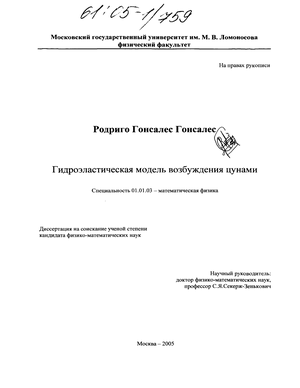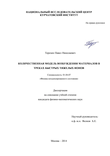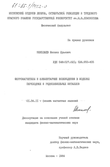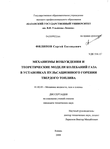Содержание к диссертации
List of Figures Hi
Acknowledgments v Introduction vii
Chapter 1. Preliminaries 1
1.1. Tsunami Events 1
1.1.1. Definition, Description and Historical Notes 2
1.1.2. Understanding the Process of a Tsunami 8
1.2. Hydroelastic Problem on Tsunami Waves Generation 15
1.2.1. Presentation 15
1.2.2. Physical Formulation of the Problem 17
1.2.3. Mathematical Statement of the Problem 19
1.3. Natural Modes of the System 23
1.3.1. Solutions for the Potentials 24
1.3.2. Dimensionless Variables 26
1.3.3. Determinant and Poles of the System 28
1.3.4. Dispersion Relations 31
Chapter 2. The Stationary Case 35
2.1. Stationary Point Source of Compression Waves 36
2.1.1. Far Field Approximation 39
2.1.2. Epicentral Zone Analysis 45
2.2. Conclusions 49
Table of Contents—Continued
Chapter 3. The Nonstationary Case 51
3.1. Nonstationary Point Source of Compression Waves 52
3.1.1. Time Variation and Spectral Function of the Acting Source . 58
3.2. Discussion of Results 61
3.2.1. Far Field Approximation 61
3.2.2. Analysis of the Epicentral Area 68
3.3. Conclusions 73
Conclusion of the Thesis 75
Appendix A. About the Math-Supporting Stuff 82
A.l. Scratch Material on Generalized Functions 82
A.l.l. The Dirac Delta Function 83
A.1.2. Green's Functions 91
A.1.3. The Images Method 94
A.2. Asymptotic Methods 98
A.2.1. Contour Integration 98
A.2.2. Method of Steepest Descent 99
A.3. Numerical Integration Algorithms 102
A.3.1. The Romberg's Method 102
A.3.2. Multiple Integrals Hybrid Algorithm 106
Appendix B. Bibliography 107
References 107
Texts 109
Links to Tsunami Web Pages 110
List of Figures
Figure 1.1. Difference between tsunami and other sea waves 3
Figure 1.2. Stages of a tsunami 11
Figure 1.3. Example of an informative bulletin for tsunami prevention . 13
Figure 1.4. Flat-ocean elastic-earth model for tsunami 18
Figure 1.5. Positive zeroes of the characteristic equation 29
Figure 1.6. Dispersion curves for tsunami and Rayleigh waves 32
Figure 1.7. Phase and Group velocities of tsunami-type waves 33
Figure 2.1. Suitable contour of integration for the far field approximation in the stationary case 41
Figure 2.2. Far field approximation for the vertical displacement solutions in the stationary case 43
Figure 2.3. Behavior of the vertical displacements for different hypocenter focal depths in the stationary case 43
FIGURE 2.4. Behavior of the vertical displacements far away from the epicenter in the stationary case 44
Figure 2.5. Suitable steepest descent path 45
Figure 2.6. Behavior of the vertical displacements at the epicenter in the stationary case 46
Figure 2.7. Behavior of the vertical displacements near the epicenter in the stationary case 47
Figure 2.8. General results at the epicentral zone for the stationary case . 48
Figure 3.1. Time history of the source 59
Figure 3.2. Contour of integration for the far field approximation approach in the nonstationary case List of Figures—Continued
Figure 3.3. Long-period dependence of the vertical displacements in the non- stationary case 65
Figure 3.4. Short-period dependence of the vertical displacements in the non- stationary case 66
Figure 3.5. Large-epicentral distance dependence of the vertical displace ments in the nonstationary case 66
Figure 3.6. Behavior of the fluid free-surface for far observation points 67
Figure 3.7. Suitable steepest descent paths 69
Figure 3.8. Long-period dependence of the vertical displacements for dis tances near the epicenter 70
Figure 3.9. Behavior of the vertical displacements in the nonstationary case 70
Figure 3.10. Short-period dependence of the vertical displacements in the non- stationary case 71
Figure 3.11. Behavior of the fluid free-surface elevation and the sea-bottom vertical displacement at the epicentral zone 72
Введение к работе
First, to him, who gave me life through my parents, who equipped me with all the necessary and always is present on myself. Infinitely grateful, God!
My sincere thanks to Dr. Sergey Ya. Sekerzh-Zenkovich, who unconditionally accepted to be my scientific advisor during my academic program of graduate studies and generously shared with me part of his mathematical knowledge on the tsunami problem, which, once I knew it, immediately attracted my attention and became to be part of my thoughts till the dissertation took form. It is important to enhance that professor Sergey Ya. also help me directly or indirectly in various aspects through my pass as a graduate foreign student of the Faculty of Physics, Moscow State University, M.V. Lomonosov. Thank you very much, Dear Professor!
During the period of my graduate program and the realization of this work, I met a lot of people whom I need to thank for their valuable help and support: specially, Dr. Valentin F. Butuzov, head of the Cathedra of Mathematical-Physics, Faculty of
• Physics, MSU, who offered an excellent opportunity to my academic life -study at the most prestigious university of Russia; Dr. Anatoly G. Yagola, distinguished professor from the Faculty of Physics, MSU, who not only advised me administratively, but in many senses in a surprising way; Natalia Nikolaevna Nikiforova, great person and excellent secretary of the International Relations Office, Faculty of Physics, MSU, who always offered her human side and helped me every time I required; Valiery Titarenko, graduate student (at the same period as mine) of the Faculty of Physics, MSU, who was an extraordinary guide in the most tedious part of my stays at the MSU, the administrative and bureaucratic procedures; and Carlos Lizarraga Celaya, my partner from the University of Sonora, who not only helped me and shared good times, but also propitiated that I enrolled and kept in the PhD program. Thanks to each of you to share with me your precious time and space!
Is my debt to thank all people from the University of Sonora, close to me by any reason, who helped me whichever had been the form. Specially, I thank to M.S. Ma. Magdalena Gonzalez Agramon, "la maestra magaly", who was the person directly responsible of the administration of scholarships at the University of Sonora, and who never hesitated to bring me the financial support for my stays at the MSUhrough her I give the thanks to my university, source of my job: I am proud to be one of its owls "El Saber de mis Hijos hard mi Grandeza" is the beautiful slogan that distinguishes us, legacy of our Universidad de Sonora.
I also want to show my thankfulness in a special form to my parents Gilberto and Petra, who drained on me the best of their energy and concreted the possibility that I am now here writing these lines; to my born family Gonzalez-Gonzalez, for all the care and wonderful memories; to my family in law Valenzuela-Chavez, for the help and love ever offered; and also to my friend Maximino Dorame Velasquez, for his friendship and the prayers he made for me. Thanks everybody to be always in the exact position!
My final acknowledgments to my wife Olga Lidia Valenzuela Chavez and to my children Amy Gabriela, Rodrigo Ivan and Olga Yvonne must be a rather different sort, since they represent the maximum treasure of my life. In ways I shall probably be the last to recognize, each of them, too, has contributed intellectual ingredients to my work. But they also, in varying degrees, done something more important. They have, that is, let it go on and even encouraged my devotion to it. Anyone who has wrestled with a project like mine will recognize what it has occasionally cost them. I do not know how to give them thanks. Instead, I will express my love for you, forever, my precious loves!
Moscow, Russia, Sincerely,
April, 2005. Rodrigo Gonzalez Gonzalez.
Introduction
A tsunami is a series of waves in the ocean generated by any rapid large-scale disturbance of the sea water. In the deep ocean, a tsunami is barely noticeable. Only as it approaches land a tsunami becomes a real hazard. As a tsunami reaches shallow water, the waves slow down and become compressed, causing them to grow up in height. In a favorable way, the tsunami comes onshore like a quickly rising tide and causes a gentle flooding of low-lying coastal areas. The more common cause of tsunamis is due to submarine earthquakes, and other possible causes are volcanic eruptions, undersea landslides, meteorological conditions or meteor impacts. Regardless of their origin, tsunamis evolve through three overlapping but quit distinct physical processes: generation by any force that disturbs the water column, propagation from deep water near the source to shallow coastal areas and, finally, inundation of land. Of these processes, the generation and inundation are the most difficult to model mathematically.
The thesis work is devoted to an analytic-numerical approach in the modeling of tsunami waves generation by submarine earthquakes.
In spite of the existence of many works concerning the tsunami problem, until now there are a lot of questions about the occurrence of tsunami that remain without a clear or convincing answer. Two types of analytical and numerical models of tsunami originated by submarine earthquakes are well known from the literature: hydrodynamic models, leading to initial condition problems for the analysis of waves in a layer of fluid over an absolutely rigid bottom, and hydroelastic models, which are concerned with the propagation of elastic waves.
In the thesis, the hydroelastic problem with a fluid layer of a constant depth over an elastic half-space in which a source generates disturbing waves is considered.
The goal of the work is the study mainly analytical and partially numerical of a hydroelastic model on tsunami waves generation. Two modes of generation are analyzed: the stationary and nonstationary cases.
The aim of the approach is the devotion to analytical solutions of the problems and their further asymptotic and numerical analysis in order to find the most impor tant tsunamigenic factors of the seismic source. Special attention was centered on the analysis of the influence of the source oscillation period on tsunami waves excitation and also on the investigation of the behavior of the waves in the epicentral area of the source. The scientific novelty of the work is that, an analytical-numerical study on the tsunami waves generation problem was made with a more realistic model than those of the predecessors, and at the same time, a rigorous mathematical analysis was possible. With this model, peculiar properties of the tsunami generation process were found.
In the stationary case, tsunamiypes waves are generated only when the period of the source is relatively long. In the nonstationary case, tsunami waves are generated only by low-frequency oscillations of the source, corresponding to the period range from 5 to 25 minutes; for a source depth of 40 km, for example, the greatest wave is attained for a period about 13-14 min. For the epicentral area and not very deep sources, it was found that there exists an interval of long-period components in the spectrum of the sources, such that the maxima of the vertical displacements of the sea-bottom are greater than the corresponding maxima of the fluid free-surface elevation. The oscillations of the fluid free-surface propagate outside of the epicenter area with velocity close to that of the long-waves, while the sea-bottom vertical displacements become very small outside of the epicentral area. This fact could be applied to the "slow or silent earthquake" phenomenon. At the epicenter and periods less than 1 min, the elevation of the fluid free-surface repeat the sea-bottom vertical variation, having decreasing values as the period becomes small.
It was found that the formulas obtained in the far field approximation are reliable for calculations if the epicentral distance is greater than 100 km. A small difference is present for the sea-bottom vertical displacement, which is due to the contribution of the integrals along the banks of the cut singularities, but it becomes insignificant as the observation point moves far away from the epicenter.
Now, let us give a brief description of the situation of the problem under consideration: the problem was first studied analytically by G.S. Pod"yapoPskiy (1968) and extensions of his analysis were essentially made by N.V. Zvolinskii (1990,1991,1993), S.Ya. Sekerzh-Zenkovich (1991,1993,1995, 2001), S.Yu. Dobrokhotov (1993,1995,2000), A.V. Kravtsov (1995) and A.A. Gvozdev (2001). Also, numerical analysis of the problem can be found in a series of published papers, as for example, H. Kanamori (1972,1993,2001), V.K. Gusyakov (1972), R. Sato (1972,1974), S.N. Ward (1980,1981), R. Comer (1984) and so on. Although many results have been obtained, until now it is not wholly clear what happen in the ocean at the epicenter area of a submarine earthquake when it excites a tsunami. As a consequence, an unacceptable 75 percent of false-alarm has prevailed since 1950 s (as documented by F.I. Gonzalez, 1999), and there is not a convincing answer to the basic formulated question why some strong earthquakes produce tsunami, while others that are expect to, do not? On the other hand, the phenomenon of "slow or silent earthquake" has not been completely explained yet. The term introduced by professor H. Kanamori, from California Institute of Technology, refers to earthquakes of moderate magnitudes that can excite exceptionally strong tsunamis. Examples of such a fatal events are Nicaragua 1992 (already classified) and Papua New Guinea 1998 (in discussion).
Note that warning systems usually issue alert preventions when the earthquake magnitude is greater than a threshold value. So, it is clear that additional information must be taken into account. At the present time, theoretical studies of tsunamis are performed basically by numerical modelling, but since the tsunami problem depends of many factors it seems that analytical study is an approach of present interest, since the results of this approach can be useful for the physical understanding of the process as well as for the numerical modeling. Although the obtained analytical solutions of the tsunami problem are given by means of complicated integrals containing combinations of special functions in their integrands, the analysis of such expressions for the solutions are successful by the use of modern methods of symbolic computation and visualization performed by fast computers.
This work continues the studies made by N.V. Zvolinslii, S.Ya. Sekerzh-Zenkovich, A.V. Kravtsov and A.A. Gvozdev, in which the above formulated question was discussed for a seismic source in the form of an expansion center with intensity changing in a stationary and nonstationary mode of oscillation, using the long-waves approximation theory to model the motion of the fluid. The conclusion made by these authors was that the existence of long-period components in the spectrum of the source plays the main role for tsunami generation. Such components were found by H. Kanamori for the Nicaraguan 1992 tsunami earthquake, and were also registered by H. Benioff (1963) for two strong earthquakes with epicenters in a continental area.
In this work the same predecessors model for the source is used, but the motion in the fluid layer is modelled by a more realistic equation without the long-waves approximation assumption.
The thesis work consists of the present descriptive introduction; mainly three chapters, which contain the basics elements to develop the improvements on the solution of the tsunami problem; a global conclusion of the thesis; one appendix that provides mathematical supporting material to get such solution; and the consulted bibliography.
In the introduction, the dissertation topic is settled, then a short description of the work and the scientific novelty are stated, and the main basic results are formulated.
In the first chapter, preliminaries concerning historical tsunami events and the characteristics on tsunamis are described and also the mathematical formulation of the problem is presented. The results obtained in this introductory part refer to the natural modes and dispersion relations of the system, which are utilized or referenced from the rest of the work.
















